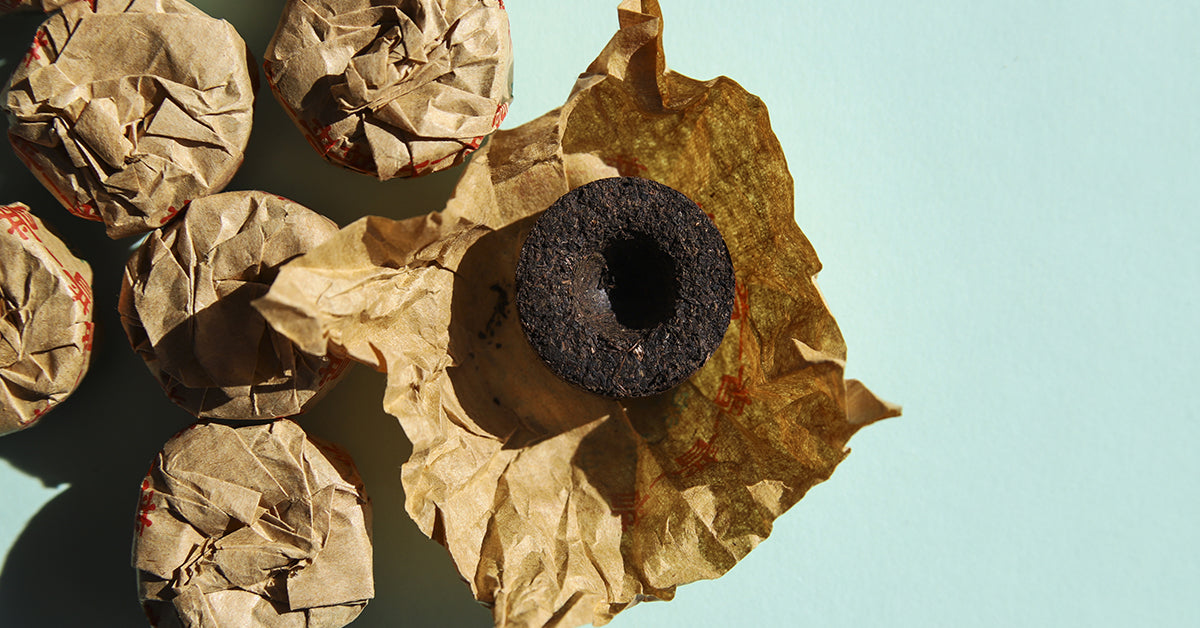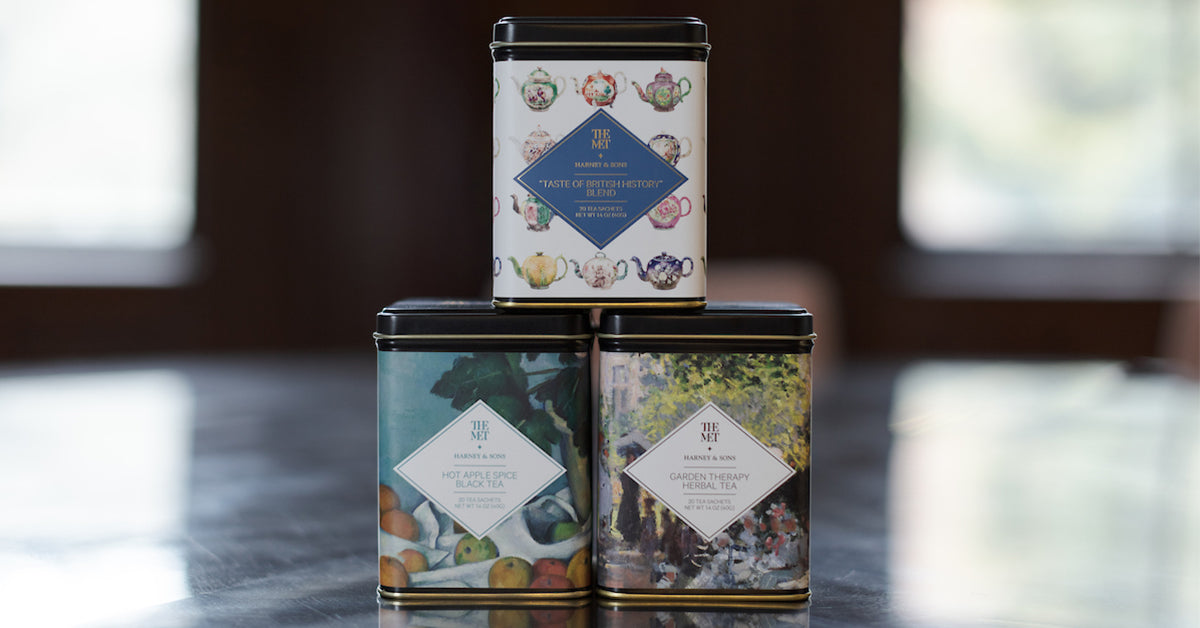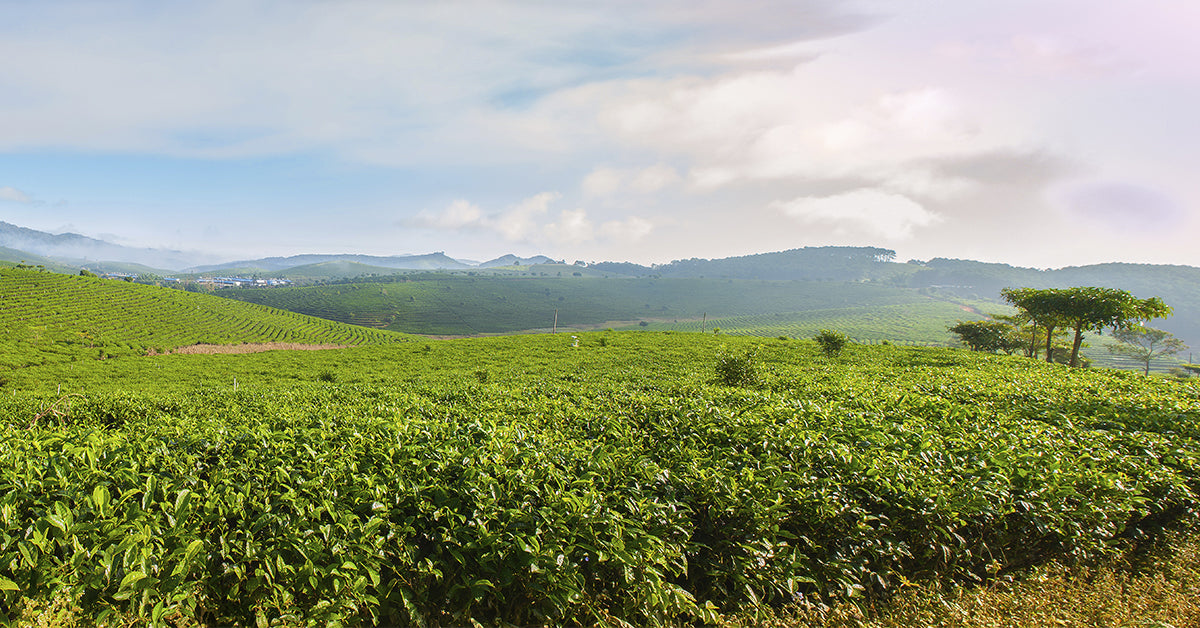Of the six main classes of teas -- five of which are black, green, white, yellow, and oolong -- pu-erh is likely the one that is most often forgotten (and the reason many people have failed to get the “name the six main types of teas” question correct in tea trivia games).
Before we dive into the deep end of the pu-erh pool, let’s talk about how you pronounce and spell this special tea. Pronounced “POOH-air,” these fermented teas may have a name that is spelled differently, but they’re all one and the same whether they are “pu-erh,” “pu-er,” “puer,” “pu’er” or “Pu-Erh.” While it may have a variety of spellings, there is no mistaking this unique aged tea. Puerh teas’ prolonged resting periods give them their own class of extraordinarily earthy flavors. No other teas taste of tobacco or musk...or even dirt. The flavor of pu-erh is sometimes described as “barnyardy.” You read that right, folks.
Pu-erhs’ Unique Taste
Pu-erhs get their unusual qualities from fermentation, a process virtually no other tea endures. The science of the pu-erh fermentation is not much understood outside of China, but we can speculate that fungal and bacterial microbes in the air likely go to work on the leaves in much the way that yeasts act on wine grapes or sourdough starters alter bread dough. These microbes convert starches and other compounds in the leaves from simple sugars into the wonderfully named “monoterpenoids,” which in turn oxidize and degrade over the years into the even more wonderfully named “sesquiterpenoids.” Sesquiterpenoid compounds are known for their earthy and camphor flavors.
For many tea drinkers, these musky flavors make pu-erhs an acquired taste. It’s no surprise the teas are among the most popular in two cities known for their unusual foods – Guangzhou (formerly Canton) and Hong Kong. Those who do acquire the taste often become unusually, almost spiritually, devoted to the tea.
Where Does Pu-erh Come From?
The tea gets its name from Pu-erh county in China’s Yunnan province, where the style likely originated. In the Tang dynasty (618-907), the region became the starting point for the Tea Horse Roads, trade routes for tea, horses, and other commodities between China and the Mongols in Tibet. One of the better stories claims that the teas fermented by accident while strapped to the horses during the long journey across the Tibetan plateau. Pu-erhs remain popular in Tibet today.
 Image: Pu-erh tea plantation in Xishuangbanna, Yunnan
Image: Pu-erh tea plantation in Xishuangbanna, Yunnan
Benefits of Drinking Pu-erh
Puerhs are prized throughout China as slimming teas. While there are no conclusive studies to prove this, the tea is often said to reduce cholesterol and blood pressure. China’s Yunnan Tea Branch, a prestigious producer of pu-erhs, also boasts that the tea “quickens your recovery from intoxication.” We will leave that for you to decide!
In large part because of its health benefits, the tea has become extraordinarily popular throughout Asia. Pu-erhs have seen a big surge in value, to the point where investors now speculate in them. Unfortunately, the speculation has also attracted counterfeiters. It is possible to find a pu-erh as many as 50 years old, but the older they get, the more likely they are to be fake. It is crucial to buy from reputable sources that get their pu-erhs from the better factories in Yunnan such as the Yunnan Tea Branch.
How Pu-erh Is Made
The very best pu-erhs are made from large-leafed tea plants native to Yunnan. The leaves are processed in one of two ways: green or raw (sheng) and a more recent style, black or cooked (shou).Green pu-erhs are the most traditional form of the tea. The leaves are fixed green on a hot surface after harvesting, withered until they grow limp, then steamed hot and compressed into cakes. The cakes are wrapped in paper and left to age for anywhere from two to 50 years. It’s possible to buy young green pu-erhs and age them at home: keep the cakes in a cool, dry place, away from mildew and damp and out of the sun, and they should last for just over a decade.
Black pu-erhs are an innovation of just the last few decades. To meet the increasing demand for the tea, researchers found a way to make a sort of imitation pu-erh that does not require aging. With the demand for pu-erhs on the rise, tea makers at the famous Menghai Tea Factory discovered a way to speed up the aging process. Instead of aging fixed green teas, tea makers oxidize them to anywhere from 40 to 90 percent. Then they put the tea through wo dui, or “moist track.” They pile the oxidized leaves into heaps, where bacteria and fungi decay them at an accelerated rate, just as in a compost pile. After a few months, leaves are fired to stop the oxidation and decay and to compress the leaves into cakes. Black pu-erhs have plenty of charm, but they lack the nuance and depth of true aged green pu-erhs.

Both types come in a charming variety of shapes. In green pu-erhs, the shapes influence the rate and quality of aging; in black teas, the shapes are just for decoration. They range from bing cha, a flat round disk, to fang cha, a square brick; tuan cha, a melon; and even jin cha, a mushroom. There’s also ping cha, which means “iron tea” – a cake so compact that it’s as solid as iron and is actually hard to break off. But ping cha also boasts even more nuanced characteristics from aging and oxidizing that much more slowly.
Brewing a Cuppa Pu-erh
As a result of their cake form, with the exception of a few loose-leafed black pu-erhs, you cannot scoop this tea into a pot with a teaspoon. To brew the tea, begin by breaking off a small chunk of the cake. The cakes can be fairly stiff; if you cannot break off a piece with your hands, use a blunt knife or letter opener to jimmy off a square. You can buy a special pu-erh knife for this purpose, but a regular table knife works fine. Since the ratio of tea to water is the same with pu-erhs as with every other tea, break off about one rounded teaspoon’s worth (or 2-2.5g) of the cake for one cup.
Unlike all other tea leaves, pu-erh leaves require rinsing to open up their flavors. Set the piece in your brewing vessel, pour in boiling water, and let stand for 30 to 45 seconds before draining. Wait a few seconds to let the drained tea awaken.

You can make just a single cup, or you can brew the leaves up to a dozen times. As with oolongs, with each round it is fascinating to observe how certain flavors emerge as others disappear. Traditionally, each brew is poured out into pu-erh tasting cups. Though each contains only a few thimbleful’s worths of liquor, after 12 of them you will feel quite alert! Puerh devotees call the buzzing sensation “pu-erh intoxication.”
There are many different ways to brew pu-erhs. Whether for a mug or a round of small cups, brew the first batch in boiling water for one to three minutes. For subsequent brews, start by steeping the tea for just 10 seconds, increasing the time by a few seconds for up to a dozen rounds. (Puerh fans sometimes time it by a number of breaths, but breaths can be so variable, seconds are more reliable.)
Ready to Try Pu-erh?
We are proud to offer only the finest pu-erh teas for an exceptional and true pu-erh experience. While the extreme, earthy flavors of pu-erhs are not for everyone, for others, once they get fermentation fever, there’s no going back!
Pu-erh. This pu-erh is a shou style, different from a sheng style as we mentioned previously, meaning it is fermented before it is packaged, compressed or sold for consumption. This particular version is a dark, savory cooked pu-erh that makes for a striking brew (Brigitte Harney is especially a fan).
Lao Ban Zhang Pu-erh. This 96g cake was manufactured in the Manwei Village of Menghai, Xishuangbanna in Yunnan province. It's rare to find a cake this small, as most pu-erh cakes are 357g. The smaller size will let you get a sense of the wonderful flavors pu-erh can offer without committing to too much tea! This pu-erh is a sheng style.
2015 Nuo Mi Pu-Erh. We're excited to offer this tuo-cha (bird's nest) pu-erh. Most of the time, we buy full cakes of pu-erhs and break them apart when we put them into the tins. Each tin of the Nuo Mi Pu-erh contains 22 tuo-chas. This pu-erh is a shou style.
Ripe Pu-Erh Balls. Like our Pu-Erh loose tea, only shaped into a nice round ball that you can simply steep without worrying about breaking into smaller pieces.
Pu-Erh Pasha Old Tree Raw 2020.
This pu-erh is from the southern border of China, from high on Pasha Mountain. It was harvested in March of 2020. This first flush tea is less oxidized and tippier than most pu-erhs. And the producers have kept the leaves loose, rather than compressing them. Being a raw or sheng puer, it retains the fresh flavors yet has the taste altered by the puer process. This makes for a distinctive Puer.
Are you a pu-erh fan? Tell us about your experience with pu-erh in the comment section.
















5 comments
Mark Van Tuyl
I recently came across Pu-Erh teas on the Harney and Sons web site and decided to give them a try. I love the earthy flavor and hint of honey. It seems like each cup is slightly different. Between Pu-Erh, Korean Pu-Erh, and Dark Tibet (which is very similar) I’ve found some new favorites.
I recently came across Pu-Erh teas on the Harney and Sons web site and decided to give them a try. I love the earthy flavor and hint of honey. It seems like each cup is slightly different. Between Pu-Erh, Korean Pu-Erh, and Dark Tibet (which is very similar) I’ve found some new favorites.
Philip Sawyer
I have drunk Pu-Erh for nearly 40 years, after first running across it as “restaurant tea” in New York’s Chinatown. It’s truly wonderful for helping with the digestion of all the oils in typical Chinese dishes. Since then, everyone has switched to jasmine or some sort of inexpensive Wulong, which doesn’t really help with the digestion. My stomach can’t deal with typical green tea, so in the meantime I found it in teabags, or switched over to Da Hong Pao, having been given some by one of my students. However, she also ended up giving me bricks of Pu-Erh, so I’m back to drinking it mostly. The smoky, earthy flavor does make it — along with Ti Kuan Yin — the “Chinese coffee” as some Chinese business acquaintances called it. Yes, it’s a bit of an acquired taste, but I always feel best after drinking it. It also works quite well with a bit of — horrors! —sugar and milk in it. LOL
I have drunk Pu-Erh for nearly 40 years, after first running across it as “restaurant tea” in New York’s Chinatown. It’s truly wonderful for helping with the digestion of all the oils in typical Chinese dishes. Since then, everyone has switched to jasmine or some sort of inexpensive Wulong, which doesn’t really help with the digestion. My stomach can’t deal with typical green tea, so in the meantime I found it in teabags, or switched over to Da Hong Pao, having been given some by one of my students. However, she also ended up giving me bricks of Pu-Erh, so I’m back to drinking it mostly. The smoky, earthy flavor does make it — along with Ti Kuan Yin — the “Chinese coffee” as some Chinese business acquaintances called it. Yes, it’s a bit of an acquired taste, but I always feel best after drinking it. It also works quite well with a bit of — horrors! —sugar and milk in it. LOL
Laura
Loved learning more about this tea from your post! When I read Lisa See’s, The Tea Girl of Hummingbird Lane I first learned of Pu-reh tea. Will need to check out H&S pu-reh! Nothing better than a good book and cup of tea!
Loved learning more about this tea from your post! When I read Lisa See’s, The Tea Girl of Hummingbird Lane I first learned of Pu-reh tea. Will need to check out H&S pu-reh! Nothing better than a good book and cup of tea!
Gemini Garner-Jones
Is decaffeinated pu-erh a mythical beast, like a qilin, or does it exist somewhere in the real world? 🤔
Is decaffeinated pu-erh a mythical beast, like a qilin, or does it exist somewhere in the real world? 🤔
Pamela
Quite a few years ago, when I was travelling to Xiomen and passed through Hong Kong, I bought a cake of Pu-Erh from the Ying Kee Tea House. I became addicted to its earthy flavor. It’s my favorite tea! The hardest part is to keep it hidden from housekeepers and a husband who think it is old and nasty and should be thrown out.
Quite a few years ago, when I was travelling to Xiomen and passed through Hong Kong, I bought a cake of Pu-Erh from the Ying Kee Tea House. I became addicted to its earthy flavor. It’s my favorite tea! The hardest part is to keep it hidden from housekeepers and a husband who think it is old and nasty and should be thrown out.